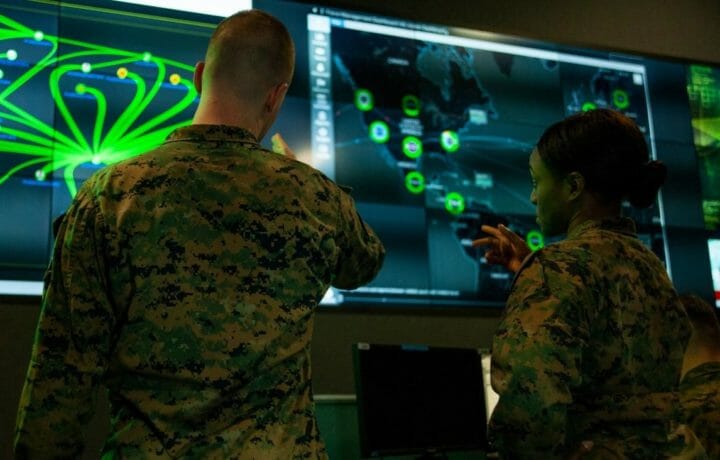The sixth and newest branch of the United States military could play a crucial role in ensuring that the country maintains an advantage over near-peer adversaries, notably China. That will require additional resources, but the United States Space Force will still need to spend wisely to get there.
Current plans call for the Space Force to harness commercial innovations from the space industry while investing to train and retain a skilled workforce that can help develop a strong digital infrastructure.
“I have never in my 25 years of service seen the department move so much money so fast toward priorities that the secretary laid out. That’s exciting,” said Col. Eric Felt, director of space architecture and integration during last week’s “State of the Space Industrial Base” webinar hosted by the National Defense Industrial Association.
The webinar addressed the need for the U.S. government to articulate a national vision for space and addressed ways that the U.S. could accelerate domestic manufacturing while strengthening supply chains for space, given the increased investment by Beijing in science and technology.
“What’s so exciting to the Space Force and the space acquisition community about all this commercial innovation is that we can use it to maintain our technology lead, and deter conflict with our competitors,” said Felt.
This includes new space systems.
“We see solutions that are going to help us get after that problem and really deliver the kinds of capabilities that our warfighters need,” added Felt. “The things that we do in space acquisition can be super helpful to our industrial base or super harmful to our industrial base.”
New NOAA Weather Satellite
The Space Force is reported to be holding discussions with the National Oceanic and Atmospheric Administration (NOAA) about replacing a geostationary weather satellite over the Indian Ocean. The current Electro-Optical Infrared Weather System-Geostationary (EWS-G) satellite provides imagery in support of the U.S. Central Command (CENTCOM).
The service is looking to work with NOAA to determine if another Geostationary Operational Environmental Satellite (GOES) satellite could succeed the EWS-G1. Even as discussions continue, efforts are already underway to update other elements of the military weather satellite fleet, SpaceNews.com reported last week.
A CubeSat built by Orion Space Solutions to gather weather imagery was launched into orbit on January 3 via a SpaceX Falcon 9 rideshare flight. The U.S. Space Force will evaluate the CubeSat’s performance over the next year as part of its Electro-optical and infrared Weather Satellite (EWS) program.
The Space Force also already has plans to launch two Weather System Follow-on-Microwave (WSF-M) satellites into orbit to provide information on ocean surface winds, tropical cyclone intensity, and space weather. The satellites are produced by Ball Aerospace and the first was purchased in 2018 and is scheduled for launch in January 2024. The second satellite, ordered last November, is currently slated to launch in 2028.
Each of the WSF-M satellites is estimated to cost $511 million, according to the Department of the Air Force. The WSF-M was designed to replace the most critical capabilities of the U.S. military’s Defense Meteorological Satellite Program (DMSP), an aging constellation that is expected to run out of service life in the coming years.
The Forces Will be AI-Ready
Future investments won’t be just in hardware. The United States Space Force, along with the United States Air Force, will need to continue to train and retain a skilled workforce while developing a strong digital infrastructure to meet the goal of being AI-ready by 2025.
Autonomous technology, using artificial intelligence (AI) and machine learning, will play a significant role in the services, which will need to continue to strengthen their data and AI infrastructure while building a stronger workforce.
The progress has been good, but there is still much more work to do, suggested Maj. Gen. John Olson, outgoing Chief Data and AI Officer (CDAO), and mobility assistant to the Chief of Space Operations, at this month’s Consumer Electronics Show in Las Vegas.
“We’re working that in earnest, we’re vigorously pursuing it. But we’re by no means there,” Olson, who is also the lead for Joint All-Domain Command and Control for the Air Force and Space Force, said in an interview with C4ISRNET following his speech. “I firmly believe that the nation that does lead in AI will lead the world because it’s critically important to everything that we do.”
The Department of the Air Force has been aiming for AI readiness by 2025, while it seeks to be AI competitive by 2027. Being AI-ready will require a trained workforce, as well as an enterprise IT architecture, Olson suggested.
There have already been more than 600 AI projects in the works at the Department of Defense as of April 2021, and the Pentagon requested $847 million for AI development for the fiscal year 2022 (FY22). Last fall, Lockheed Martin and IBM subsidiary Red Hat announced their collaboration to tackle challenges that the DoD faces in the AI space and advance AI innovation for the department.
While Olson will move out of his CDAO role, he has said that the Air Force and Space will need to continue to pursue of AI projects with an ever greater sense of urgency.
“I think we need to accelerate,” Olson said. “We need to be much more focused and operating with a much greater sense of urgency.”


